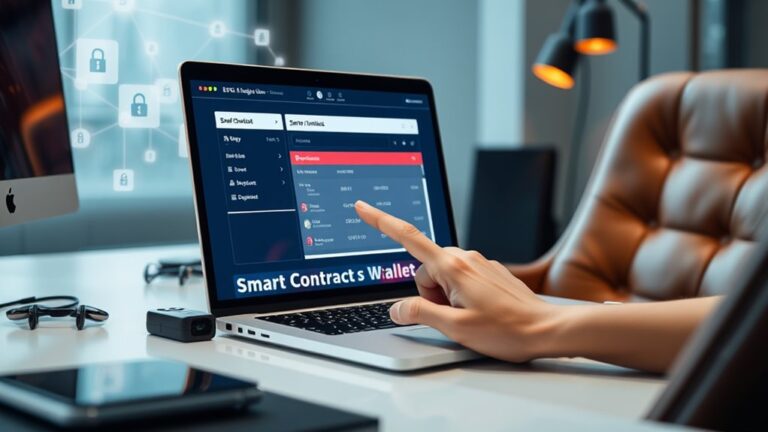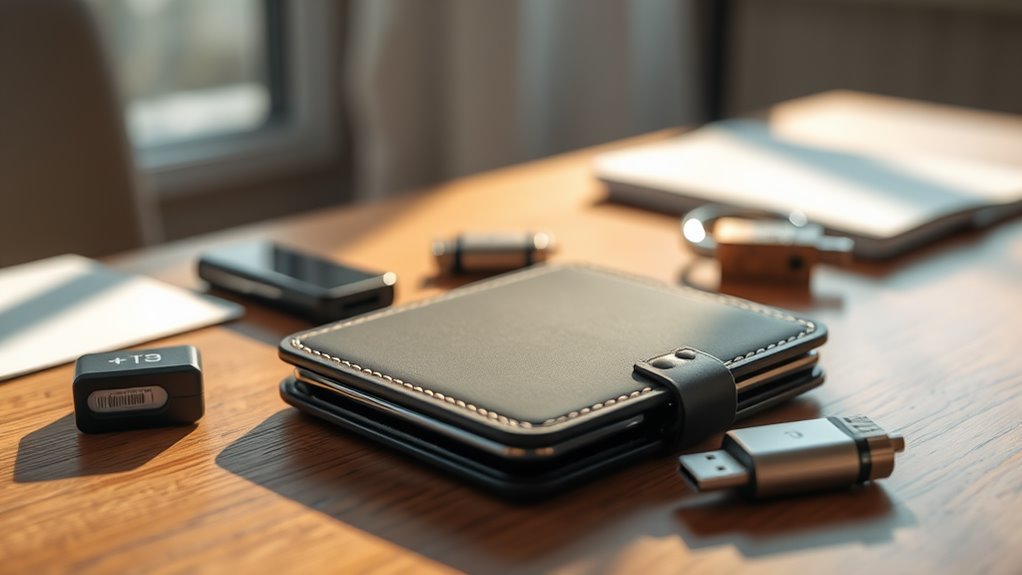
Secure Your Crypto Wallet: Essential Safety Tips Now
To secure a cryptocurrency wallet effectively, one should choose between hot and cold wallets based on transaction frequency and security needs. Implement strong password practices and enable two-factor authentication for added protection. Regularly update software to guarantee the latest security measures are in place. Be cautious of phishing attempts by verifying URLs and avoiding unsolicited emails. Finally, maintain a backup of private keys and seed phrases to prevent loss. More thorough strategies can enhance overall security.
Key Takeaways
- Use strong, unique passwords and enable two-factor authentication (2FA) to enhance your wallet’s security.
- Regularly update wallet software and apps to ensure you have the latest security patches.
- Store backups of your private keys and seed phrases in secure, offline locations.
- Be cautious of phishing attempts; verify URLs and avoid clicking on links from unsolicited emails.
- Utilize a combination of hot and cold wallets to balance convenience and security for your cryptocurrency holdings.
Choosing the Right Wallet Type
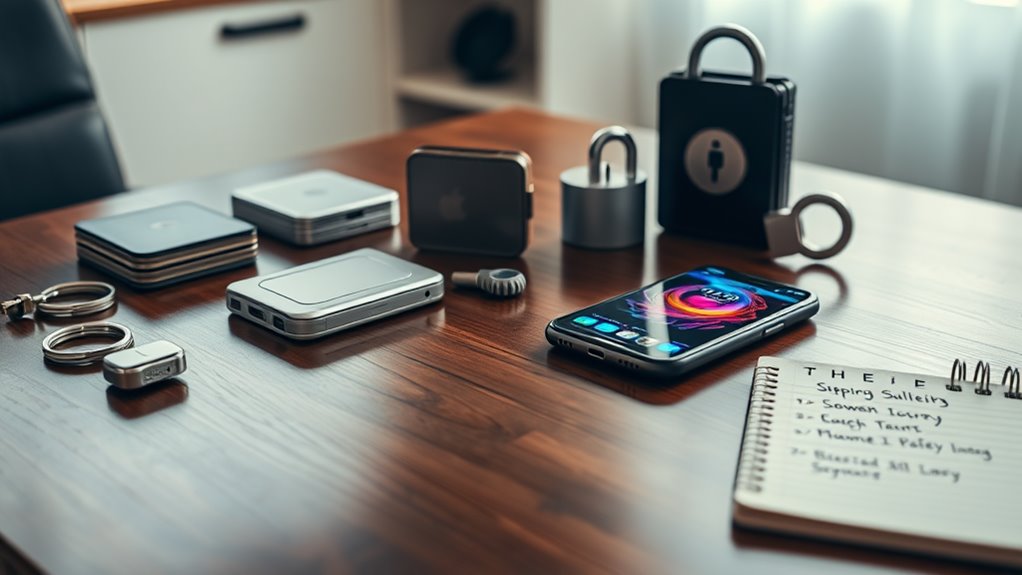
When selecting a cryptocurrency wallet, individuals often wonder which type best suits their needs. There are primarily two categories: hot wallets and cold wallets.
Hot wallets, which are internet-connected applications, offer mobility and quick access for frequent transactions. However, their online nature increases vulnerability to hacks. Popular examples include Coinbase Wallet and Trust Wallet.
Hot wallets provide convenient access for frequent transactions but come with increased risks of online hacks.
In contrast, cold wallets store cryptocurrencies offline, greatly reducing the risk of online attacks. They offer enhanced security but require physical access for transactions, making them less convenient for frequent use.
Individuals should consider their transaction frequency and security requirements when choosing a wallet type. This decision hinges on balancing convenience with the level of protection necessary for their cryptocurrency holdings. Many users opt for a combination of both wallet types to achieve a balance of convenience and security.
Securing Your Data and Access
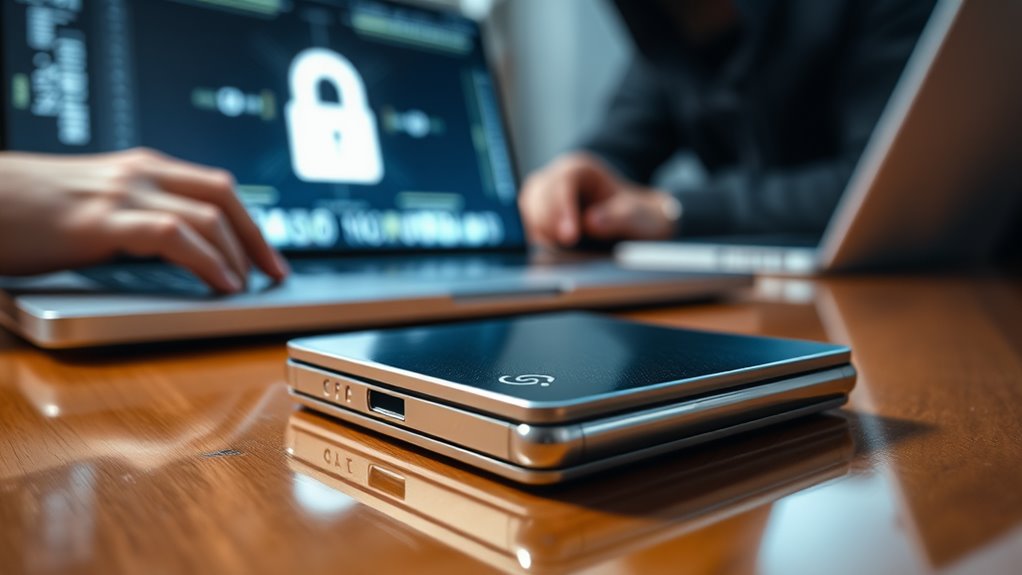
When securing a cryptocurrency wallet, strong password practices and two-factor authentication (2FA) are essential components to contemplate. Utilizing complex, unique passwords reduces the risk of unauthorized access, while implementing 2FA adds an additional verification step that enhances overall security. Together, these measures create a robust defense against potential threats to sensitive data and access. Additionally, keeping software and apps up to date ensures that users benefit from the latest security patches, further protecting their crypto assets.
Strong Password Practices
Creating strong passwords is essential for securing personal data and access to crypto wallets. Passwords should include a mix of uppercase and lowercase letters, numbers, and symbols to enhance complexity.
It is vital to avoid reusing passwords across different accounts, especially for sensitive crypto-related platforms. Unique and lengthy password sequences are less susceptible to guessing. Utilizing a password manager can aid in generating and securely storing these passwords.
Additionally, individuals should regularly update their passwords if they suspect any compromise. Common patterns, such as birthdays or names, should be avoided to further strengthen security.
Finally, keeping passwords offline can protect against digital breaches, ensuring that sensitive information remains secure. Furthermore, employing strong passwords with two-factor authentication adds an extra layer of protection to your accounts.
Two-Factor Authentication Benefits
Two-Factor Authentication (2FA) serves as a critical layer of security for individuals accessing cryptocurrency accounts, considerably reducing the risk of unauthorized access. By requiring two forms of verification, 2FA enhances account safety and protects sensitive data. Common methods include authenticator apps, SMS codes, and hardware tokens. Implementing multisig wallets can further bolster security by requiring multiple approvals for transactions.
| Benefits | Description | Examples |
|---|---|---|
| Enhanced Security | Reduces risk of access with stolen passwords | Authenticator apps |
| Protection Against Hacking | Prevents access even with compromised passwords | SMS verification codes |
| Safer Transactions | Requires dual verification for actions | Hardware tokens |
| Easy Setup | Simple to implement for all users | Various platforms |
Implementing 2FA fosters a more secure cryptocurrency environment, benefiting users and exchanges alike.
Preventing Phishing and Scams
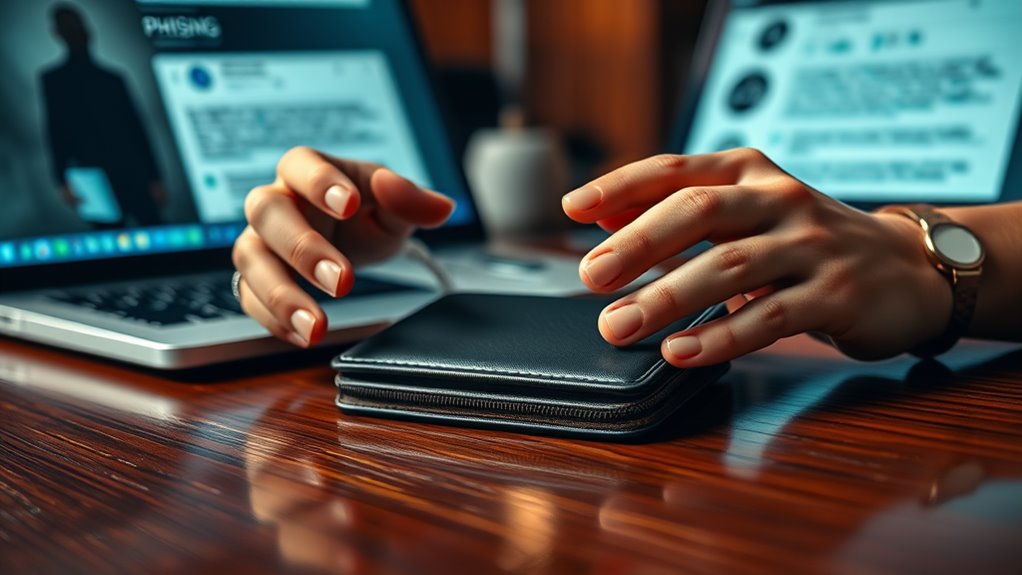
Phishing and scams pose significant risks to cryptocurrency users, making it essential to adopt effective preventive measures.
Users should verify URLs carefully, as phishers often create similar links with slight misspellings. Ensuring that websites use HTTPS and display a padlock icon is critical for safety.
Unsolicited emails may contain fake links, so it is important to avoid clicking on these. Additionally, urgency tactics are common in phishing attempts, urging users to act quickly without confirmation.
Bookmarking official sites can prevent accidental visits to fraudulent pages. Users must also recognize impersonation scams and be cautious of fake browser extensions and social media requests for sensitive information.
Staying informed about these threats is necessary for safeguarding cryptocurrency assets. Furthermore, keeping your wallet keys private is a vital practice that can significantly reduce the risk of falling victim to scams.
Enhancing Physical and Biometric Security

Enhancing physical and biometric security is essential for safeguarding cryptocurrency assets.
Hardware wallets offer robust protection by storing private keys offline, while biometric authentication methods, such as fingerprint and facial recognition, add an extra layer of access control. By employing hardware wallets, users can significantly reduce the risk of online threats that often target digital assets. Together, these strategies help users protect their digital wealth from unauthorized access and potential theft.
Hardware Wallet Benefits
Hardware wallets offer significant benefits regarding physical and biometric security, making them a preferred choice for many cryptocurrency users.
These devices store private keys offline, shielding them from online threats such as hacking and malware. Transactions are signed within the hardware wallet, ensuring the private key remains secure.
Physical security is enhanced as users must interact with the device to authorize transactions, reducing the risk of phishing scams. Many hardware wallets support multiple cryptocurrencies, allowing users to manage various assets efficiently.
Additionally, they provide full custody control over digital assets, unlike custodial services. With features like PIN protection and secure key generation, hardware wallets deliver an impressive level of security, making them a reliable option for safeguarding cryptocurrency investments. Furthermore, they play a crucial role in managing access to digital assets on the blockchain, ensuring that users can safely conduct transactions without exposing their private keys.
Biometric Authentication Options
How can biometric authentication enhance the security of cryptocurrency wallets? Biometric authentication utilizes unique physical characteristics, such as fingerprints, facial recognition, and iris scans, making it more secure than traditional passwords. This method is difficult to compromise, reducing the likelihood of unauthorized access.
Many platforms store only hashed biometric data, ensuring user privacy while complying with regulations. Additionally, biometric authentication accelerates the login process and offers high accuracy, with a low false match rate.
The integration of military-grade secure elements and tamper-resistant designs further enhances physical security in biometric wallets. Combined with regular software updates and encrypted storage, biometric authentication presents a robust solution for securing cryptocurrency assets against potential threats. Moreover, AI-driven threat detection is increasingly being used to complement biometric systems, providing an additional layer of security against sophisticated attacks.
Regular Maintenance and Backup Practices
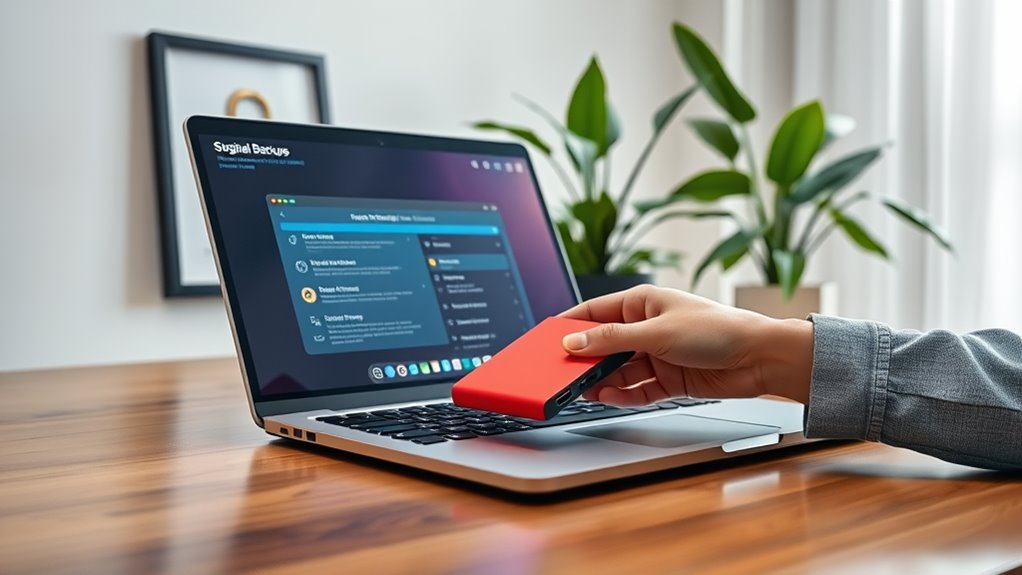
Regular maintenance and backup practices are essential for safeguarding cryptocurrency wallets, as they help prevent loss and enhance security.
Regular maintenance and backup practices are crucial for protecting cryptocurrency wallets and ensuring enhanced security against potential loss.
Regular software updates guarantee wallets have the latest security patches, and effective backup strategies protect private keys and seed phrases.
Users should adopt the following practices:
- Regular Updates: Install updates promptly to fix vulnerabilities and improve features.
- Secure Storage: Keep backups of private keys in safe locations, utilizing both physical and encrypted digital methods.
- Backup Verification: Periodically test backups to verify they are functional and accessible.
Additionally, users should be aware of the importance of strong security measures like unique passwords and two-factor authentication to further protect their wallets.
Establishing an Incident Response Plan

In the domain of cryptocurrency, safeguarding assets requires not only regular maintenance and backup practices but also a well-structured incident response plan. This plan is essential for effectively managing and mitigating threats to crypto wallets.
First, organizations should define roles and responsibilities to clarify who responds during an incident. Next, establishing communication protocols guarantees that both internal teams and external stakeholders are promptly informed.
Conducting risk assessments helps identify potential vulnerabilities. Regular training and drills prepare teams for real security incidents, while ongoing reviews keep the plan updated with emerging threats. Additionally, it is crucial to emphasize the importance of seed phrases as a primary recovery mechanism for accessing digital assets in the event of a security breach.
Frequently Asked Questions
What Is the Difference Between Public and Private Keys?
The difference between public and private keys lies in their functions; public keys receive funds and can be shared openly, while private keys authenticate transactions and must remain confidential to protect control over cryptocurrency assets.
How Do I Recover My Wallet if I Lose Access?
To recover a wallet after losing access, one should utilize the seed phrase, contact wallet support, check old devices, or employ professional recovery services, ensuring that secure backup methods are established to prevent future losses.
Can I Use Multiple Wallets for Different Cryptocurrencies?
Research indicates that users who manage multiple wallets for different cryptocurrencies experience a 30% reduction in overall risk. This strategy enhances security, enables portfolio diversification, and facilitates organized management of various digital assets effectively.
Are There Fees Associated With Transferring Crypto Between Wallets?
Transferring cryptocurrencies between wallets typically incurs network fees, which vary by currency and network conditions. Factors like congestion and transaction complexity influence these fees, necessitating awareness for cost-effective transfers. Customization options may also be available.
How Can I Verify My Wallet’s Security Features?
To verify a wallet’s security features, one should review its authentication methods, transaction approval processes, key management practices, and software update protocols. Additionally, checking for user feedback and independent audits enhances confidence in its security.
Conclusion
To summarize, securing a crypto wallet is essential for protecting digital assets from theft and loss. For instance, a well-known case involved a hacker exploiting weak passwords, resulting in millions lost from user wallets. By selecting the appropriate wallet type, implementing strong security practices, and remaining vigilant against scams, individuals can greatly reduce their risk. Regular maintenance and an incident response plan further enhance security, ensuring a proactive approach to safeguarding valuable cryptocurrencies.




